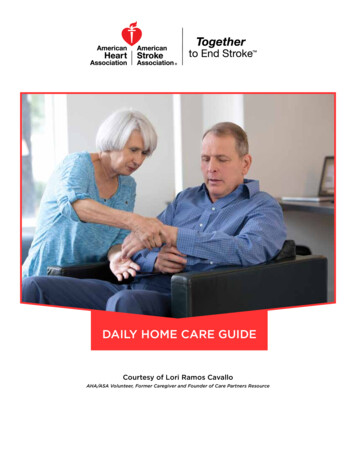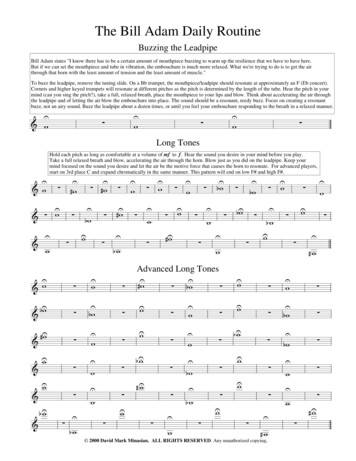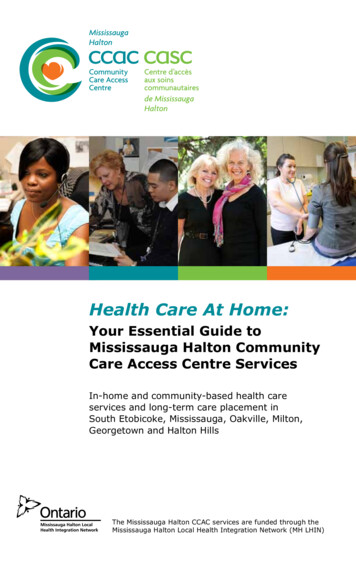
Transcription
DAILY HOME CARE GUIDECourtesy of Lori Ramos CavalloAHA/ASA Volunteer, Former Caregiver and Founder of Care Partners Resource
INTRODUCTIONCaring for a stroke survivor can be overwhelming. If you can’t always carefor your loved one, you’ll need a temporary caregiver. Use this Daily HomeCare Guide to record your loved one’s daily needs so a temporary caregiverwill know what to do. This will help ensure that your loved one gets propercare when you aren’t there.INSTRUCTIONSComplete the fields in the guide as described in the instructions below, print and staplepages 1-9 of the guide and give it to anyone who cares for your loved one when you’reaway. Also give it to friends and/or family members who may need it in an emergency.Background Information (Page 1) 1. Fill in your loved one’s name and your name.2. Make copies of your loved one’s driver’s license, insurance card, Social Securitycard and Advance Directive/5 Wishes/DNR documentation.3. Enclose the copies with this guide and keep copies in your possession, in thestroke survivor’s possession and in your car in case of emergency.Emergency Contact Information (Page 2) 1. Fill in your contact information as well as the information for otherindividuals who can provide assistance if you are not available.Physician Information (Page 3)1. Fill in the physicians your loved one works with, such as his/her Primary CarePhysician, Nurse Case Manager or Social Worker, Neurologist, Cardiologist, SpeechTherapist, Occupational Therapist, etc.Medical Conditions (Page 4)1. List all of your loved one’s medical conditions, the date he/she was diagnosedif you know (general time frame is OK if you don’t), and how the diagnosis istreated/managed.Daily Home Care Guide for:i
INSTRUCTIONSAllergies (Page 4)1. List all of your loved one’s allergies and how each is treated/managed.Medications (Page 5) 1. In the chart, list all the medications your loved one takes.2. Enter the dosage and the day(s) and time(s) he/she takes them. Be sure to includethe medication time and day in the Daily Activities section (page 10) as well.3. Enter the purpose of the medication and any additional information the temporarycaregiver may need.4. At the bottom, enter your loved one’s pharmacist, the pharmacist’s direct numberand the pharmacy name, address and number.Therapy Log (Page 6)1. Make a copy of your therapy sheet(s) from the physical therapist, speech therapistand/or occupational therapist.2. Include the copies with this sheet and/or complete the fields in the table.3. Be sure to enter these exercises in the Daily Activities section (page 7) as well.Daily Activities (Pages 7-8)1. Enter the time, day(s), activity and activity details in the boxes. Be sure to includeeverything your loved one does/needs each day, including dressing, eating,medications, exercise activities, etc. Also include any assistance he/she may needwith each task, what his/her preferences are, time limits, etc.Additional Notes (Page 9)1. Record any additional notes the temporary caregiver may need in your absence.Daily Home Care Guide for:ii
BACKGROUND INFORMATIONDaily Home Care Guide for:Stroke Survivor’s NameSee Enclosed Copies of:Primary Caregiver:Caregiver’s Name Driver’s license Insurance card (Include Medicare & Supplemental, if applicable) Social Security card (or place in safe location where temporary caregiver couldget it in an emergency) Advance Directive/5 Wishes/DNR documentationDaily Home Care Guide for:1
EMERGENCY CONTACT INFORMATIONHome Phone:Address:City: State: Zip:1st Contact:NameHome Phone: Cell:Work:2nd Contact:NameHome Phone: Cell:Work:3rd Contact:NameHome Phone: Cell:Work:Daily Home Care Guide for:2
PHYSICIAN INFORMATIONName:Specialty: Phone Number:Name:Specialty: Phone Number:Name:Specialty: Phone Number:Name:Specialty: Phone Number:Name:Specialty: Phone Number:Name:Specialty: Phone Number:Daily Home Care Guide for:3
MEDICAL CONDITIONSMedical ConditionsExample: Type 2 DiabetesDateDiagnosed 1/2/10TreatmentManaged with medications.ALLERGIESAllergiesExample: Peanut allergyTreatmentExample: Avoid all foods containing peanuts–look at ingredients on all productlabels (everything in house is peanut-free). Use EpiPen in case of allergic reaction.Daily Home Care Guide for:4
MEDICATIONSMedicationsDosageDay(s)Time(s)Example: Aspirin325 mgDaily8:00 amPurposePrevent bloodclots.CommentsTake one daily.Pharmacist:Direct Number:Pharmacy Name:Pharmacy Address: City:State: Zip:Daily Home Care Guide for:5
THERAPY LOGDay/TimeExample:M, W7 ty DescriptionTherapistExample:Practice vocalizationand exercise weakmuscles.Example: Take the picturecards (on Bob’s bedsidetable) and sit down withBob. Show him each cardand let him sound outthe name of the object.Go through the cards atleast twice.Example:Jeremy JohnsonDaily Home Care Guide for:6
DAILY ACTIVITIESTime8:00–8:15 a.m.Day(s)Example:Every DayActivityExample: Wake UpDetailsExample: Bob wakes up at 8:00 a.m.every morning when his alarm clocksounds. He does not need any helpgetting out of bed, but it takes himabout 10 minutes to get up. Makesure he goes straight to the bathroomafter he wakes up. He does not needassistance, but ensure that he takesno more than 5 minutes.(1 of 2)Daily Home Care Guide for:7
DAILY ACTIVITIES (cont’d)TimeDay(s)ActivityDetails(2 of 2)Daily Home Care Guide for:8
ADDITIONAL Daily Home Care Guide for:9
Daily Home Care Guide for:_ i INTRODUCTION Caring for a stroke survivor can be overwhelming. If you can’t always care for your loved one, you’ll need a temporary caregiver. Use this Daily Home Care Guide to record your loved one’s daily needs so a temporary caregiver will know what to do. This will help ensure that your loved one gets proper care when you aren’t there. INSTRUCTIONS .











